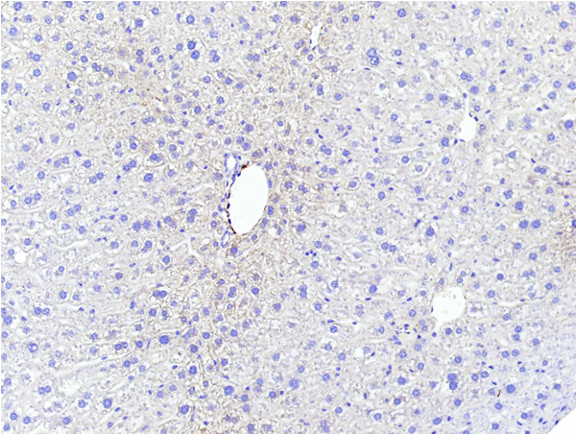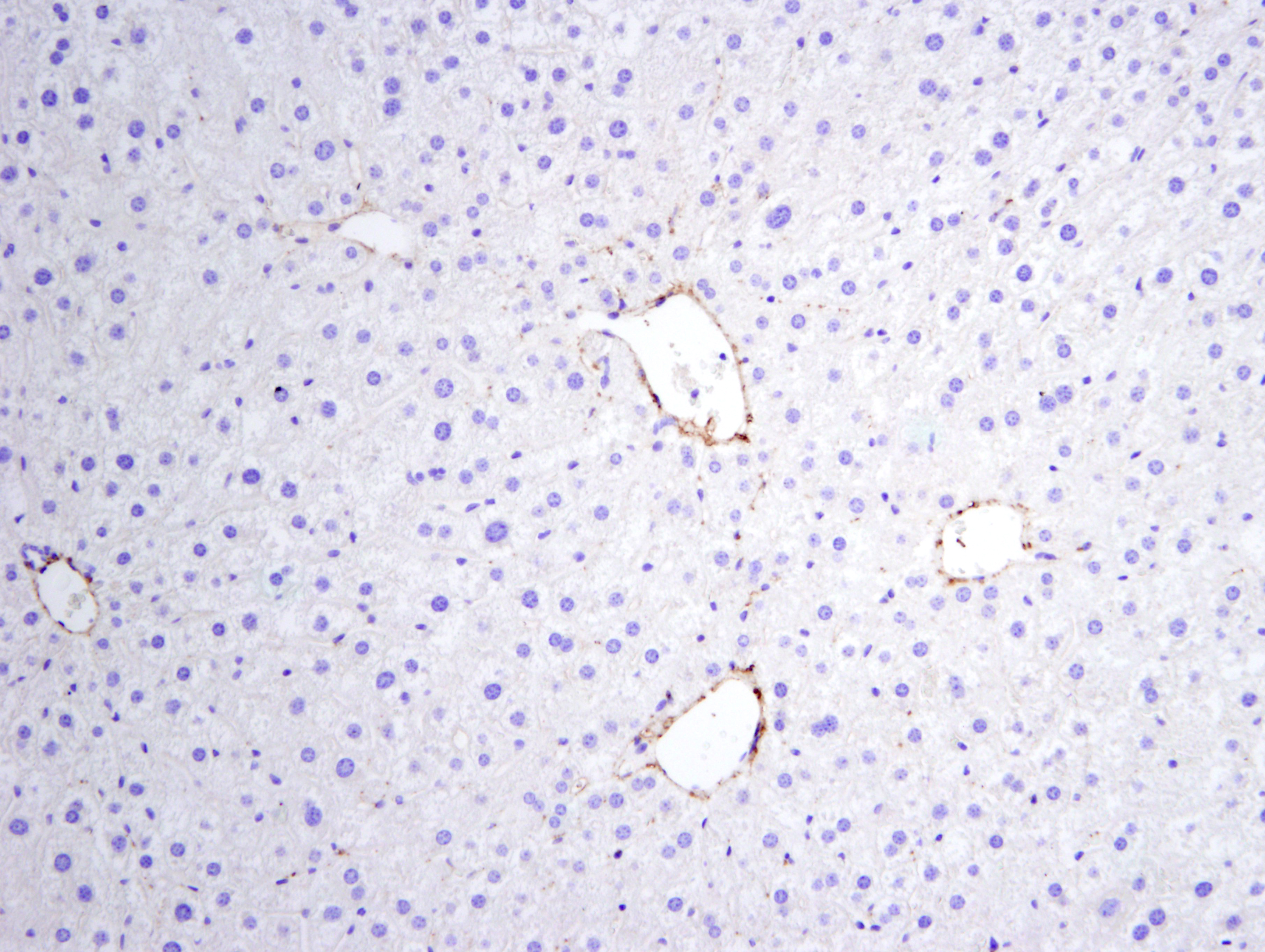| Model No. | Nomenclature | Genotype |
|---|---|---|
| NASH-B6-M | C57BL/6NTac | |
| NASH-B6-CONTROL-M | C57BL/6NTac |
Diet Induced NASH B6

- Description
- Data
- Growth Chart
- Price & Licensing
- Health Report
- Overview
- Genetics
- Guides & Publications
- Applications & Therapeutic Areas
- Transit, Housing & Welfare
Overview
Nomenclature: C57BL/6NTac
Taconic is the first and only vendor to offer a diet-induced NASH mouse model off the shelf
Taconic Biosciences maintains an inventory of C57BL/6NTac male mice conditioned on a modified Amylin liver NASH (AMLN) diet. Diet # D09100310i (source Research Diets) contains 40 kcal% fat, 20 kcal% fructose and 2% cholesterol and is an irradiated diet. This diet is sometimes called the Gubra-Amylin NASH diet or GAN diet. C57BL/6NTac males are put on this diet at 6 weeks of age and housed at reduced density. Control C57BL/6NTac male mice are housed in the same location, also at reduced density, and are fed the NIH-31M chow diet. Control males can also be generated using a low-fat purified diet upon request.Nonalcoholic Steatohepatitis (NASH) B6 mice become obese, develop a fatty liver, and develop liver inflammation and fibrosis after 26+ weeks on the diet. Inter-animal variability is observed in the progression of the inflammation and fibrosis phenotypes. They have significantly elevated serum levels of the liver enzyme alanine aminotransferase (ALT) compared to controls, display robust steatosis, display hepatic inflammation including the presence of hepatic crown-like structures, have activated stellate cells, and develop consistent fibrosis by 26 weeks on the diet (fibrosis score of 2 on a scale from 0-4 for most animals in one study, with bridging fibrosis observed only rarely and at late stages (1/10 mice at 53 weeks on diet)). More information is available in the phenotypic data tab below as well as in several webinar presentations: The Diet Induced NASH B6: A Translational NASH Model for Drug Discovery and Histopathological Characterization of the Diet Induced NASH B6. The Taconic diet-induced NASH B6 mouse model recapitulates many of the key features of human disease and has been successfully used in drug discovery research in nonalcoholic steatohepatitis.
NASH B6 mice in transit for an extended period of time (more than 48 hours by ground or any air transit) can lose 10-20% of their body weight and may require extended acclimation (two or more weeks). Weight loss induced by transit may delay disease phenotype relative to animals which have remained in the same facility for the entire conditioning period. Additionally, phenotypic penetrance of certain NASH phenotypes is incomplete, so animals conditioned on diet for the same length of time will vary in disease phenotype. Taconic recommends a pilot study to determine the appropriate number of mice to order for a specific study type.
Alopecia may occur in NASH mice and is thought to be a consequence of the metabolic disease phenotype. As long as the skin is normal and intact and no pruritus is observed, no treatment is required and the mice may be used in experiments.
We recommend you review Policies, Recommendations, & Resources for Taconic's Diet Induced NASH Model prior to ordering. It includes important recommendations to support experimental success and animal welfare.
NOTE: The NASH diet D09100310i may take several weeks to receive after ordering from Research Diets. Please ensure you understand timeline of diet receipt in your facility prior to ordering mice. Taconic cannot provide the NASH diet beyond the amount the mice are shipped with in the TTC for use in transit.
Tissue collection: Taconic can provide murine biospecimen collections on NASH and control animals as a separate service. Our Murine Biospecimen Services (MBS) provides general tissue and biospecimen collections which include blood, plasma, serum, liver, adipose tissue and many others. We offer various preservation methods including snap freezing, immersion in 10% neutral buffered formalin or immersion in culture media. Contact us for a complete list of available tissues and services.
Custom Diet Conditioning:Taconic also offers custom diet conditioning for any commercial or customer-provided strain as part of its Colony Management Solutions portfolio.
Disease stages in Taconic's Diet Induced NASH B6

Genetics
Guides & Publications
Initial Publication:
- Bernardo B et al. Comprehensive characterization of an off-the-shelf modified AMLN mouse model and considerations for experimental design targeting steatotic, inflammatory and fibrotic endpoints. Poster presented at AASLD 2020. Additional publications describing applications for similar models are below.
Other Publications:
- Trevaskis JL et al. Glucagon-like peptide-1 receptor agonism improves metabolic, biochemical, and histopathological indices of nonalcoholic steatohepatitis in mice. Am J Physiol Gastrointest Liver Physiol 2012; 302: G762-G772. – original AMLN paper.
- Kristiansen MN et al. Obese diet-induced mouse models of nonalcoholic steatohepatitis-tracking disease by liver biopsy. World J Hepatol. 2016 Jun 8;8(16):673-84. – overview of B6J (DIO) AMLN model at 26 week timepoint.
- Hansen HH et al. Mouse models of nonalcoholic steatohepatitis in preclinical drug development. Drug Discov Today. 2017 Nov;22(11):1707-1718 - 2017 review paper with a table of compounds tested in the AMLN model.
- Hernandez ED et al. Tropifexor‐mediated abrogation of steatohepatitis and fibrosis is associated with the antioxidative gene expression profile in rodents. Hepatology Communications 2019. – use of original AMLN model to evaluate FXR agonist therapeutic.
- Oldham S et al. Incorporation of a Survivable Liver Biopsy Procedure in Mice to Assess Non-alcoholic Steatohepatitis (NASH) Resolution. Journal of Visualized Experiments 2019, No. 146. – survival liver biopsy technique to assess NASH stage prior to study start.
Applications & Therapeutic Areas
- Metabolic Disease
Transit, Housing & Welfare
Need more info? Click the live chat button or Contact Us
NASH B6 animals and NASH B6 controls are packed as cagemates, one cage per Taconic Transit Cage (TTC). We recommend that customers do NOT recombine animals from different TTCs into the same cage at or after unpacking.
Please see important information regarding recommended housing and husbandry along with potential adverse phenotypes in Policies, Recommendations, & Resources for Taconic’s Diet Induced NASH Model.
- Data
- Histopathology Gallery (Liver)

Figure 1: Comparison between C57BL/6NTac mice placed on D09100310 diet (NASH B6NTac) or kept on chow diet (Control B6NTac) from 5 weeks of age. A) Liver weight as a percentage of total body weight. B) Liver hydroxyproline content. C) Liver triglycerides. D) Serum alanine aminotransferase levels (ALT). For each time point, n=8 for NASH B6NTac and n=4 for Control B6NTac. Different individual animals were used for each time point (i.e. data is not longitudinal by animal). * and ** indicate statistical significance between NASH and control animals. Two-way ANOVA with multiple comparisons, with p-value<0.05* or p-value<0.01** Data provided by an anonymous pharmaceutical company.

Figure 2: NASH B6 have significantly elevated alanine aminotransferase (ALT) plasma levels. 2-way ANOVA Diet x Time: Only Diet is significant p< 0.0001. Sidak's Multiple Comparisons Test. Not Longitudinal.
27 Weeks on Diet

35 Weeks on Diet

53 Weeks on Diet
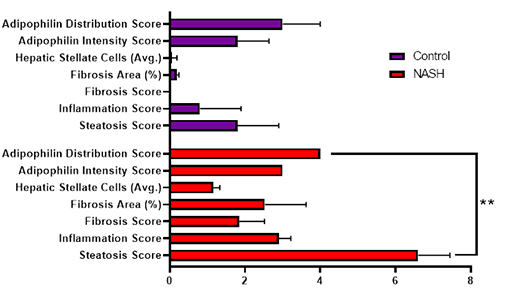
Figure 3: Summary of quantitative histology findings. T-Test Multiple Comparisons: Separate Analysis per Time, Unpaired. Significance level p<0.001
A

B

Figure 4: (A) Fibrosis score and (B) % fibrosis area. 2-Way ANOVA Time x Diet: Sidak's Multiple Comparisons. Significance level p<0.0001. Not Longitudinal. Fibrosis Score - Only diet is significant. % Fibrosis Area - Time vs Diet is significant and STRONG INTERACTION.

Figure 5: NASH B6 have hepatic crown-like structures (hCLS), a unique histological finding from NASH patients. Hepatic crown-like structures (blue arrowheads) are macrophages surrounding hepatocytes with large lipid vacuoles. Macrophages also form solid inflammatory cell aggregates with other leukocytes (red arrowheads).

Figure 6: Histopathology for C57BL/6NTac mice placed on D09100310 diet (NASH B6NTac) or kept on chow diet (Control B6NTac) from 6 weeks of age. Animals were on diet for 27, 35 or 53 weeks. Hematoxylin and eosin (H&E) staining illustrates morphological changes including steatosis and infiltration of immune cells. Activated HSCs were identified in liver sections by using a rabbit polyclonal antibody to alpha-smooth muscle actin (a-SMA) (1:500 dilution; ab5694; Abcam, Cambridge, MA) which was detected by an anti-rabbit IgG embedded polymer with embedded horseradish peroxidase and visualized with 3,3′-diaminobenzidine (DAB) chromogen (Agilent, Carpentaria, CA). Hepatocellular lipid droplets were identified by visualization of the lipid-binding protein adipophilin known to be expressed in steatotic livers. Sections of livers were probed using a rabbit polyclonal anti-adipophilin antibody (1:200 dilution; NB110-40877, Novus Biologics, Littleton, CO) which was detected by an anti-rabbit IgG embedded polymer with embedded horseradish peroxidase and visualized with 3,3′-diaminobenzidine (DAB) chromogen (Aligent, Carpentaria, CA). Picrosirius red (PSR) staining illustrates collagen I and III fibers and is used to measure fibrosis. The same individual NASH or control animal is shown for all four stains in a particular time point. Different individual animals were used for each time point (i.e. data is not longitudinal by animal). Histopathology services provided by IDEXX BioAnalytics.
Necropsy results for NASH and chow control mice between 22-59 weeks of age
C57BL/6NTac mice either on NASH diet D09100310i or on control NIH-31M chow diet were necropsied at 22 (NASH only, no controls), 33, 41 or 59 weeks of age. With the exception of the 59 weeks of age group, NASH mice were selected as two full cagemate groups (10 total mice, 5 mice/cage). A portion of liver was collected for histopathology analysis. The remainder of the liver was dissected and any gross lesions or abnormalities were noted.General NASH mouse findings: All mice were bright, alert and responsive. Fur coat condition was visibly oily and all mice had body condition score 5/5. Alopecia/barbering was evident in some mice, as were healed fight wounds. All animals had marked mesentary and subcutaneous adipose tissue. Liver in all mice was grossly pale to tan, smooth, and uniformly enlarged. All mice displayed moderate diffuse hepatomegaly with steatosis. For nearly all mice, no masses or lesions were observed on serosal or cut side of livers.
The following findings were noted: Male M671 (33 weeks old) was found to have an approximately 1.0 mm lesion, flat, circular, flush to the medial lobe, milky white in coloration, located on the lower right side of the medial lobe (Fig 7). In the 59 week old group, visible suspect lesions with fat-like deposit appearance measuring approximately 0.1 - 0.4 cm on serosal side of liver were found in M444, M445, M652, M653. Portions of M652 and M653 (Fig. 9) livers showing suspect lesions were fixed and sent for pathology analysis. M655 showed a hepatic mass measuring approximately 0.8 cm, located between the left and caudal lobe tissues (Fig. 10); this was fixed and sent for pathology analysis.
Final histopathology report on 59 week old NASH mice found liver adenomas that compressed the adjacent parenchyma in 2 out of 10 mice (M655 and M444), foci of hepatocellular alteration and proliferation in 4 of 10 mice (M443, M444, M445, M652) and oval cell hyperplasia in all but 1 mouse (M770). An incidental finding observed in 1 of 10 mice (M655) was the presence of large aggregates of mononuclear cells including large and small lymphocytes, plasma cells and dendritic-like cells adjacent to central veins. These aggregates have features of lymphocyte neoplasia most consistent with follicular lymphoma (also described as follicular B-cell lymphoma), a common age-related neoplastic condition of C57BL/6 mice. No hepatocellular carcinoma was identified by histopathology in any of the NASH mice examined at 27, 35 or 53 weeks on diet (10/group).

Figure 7: Liver of C57BL/6NTac mouse
on NASH diet D09100310i for 27 weeks
displays moderate diffuse hepatomegaly
with steatosis. This mouse (Male M671)
displayed a flat lesion flush to
the medial lobe.

Figure 8: Liver of C57BL/6NTac mouse on
NASH diet D09100310i for 35 weeks
displays moderate diffuse hepatomegaly
with steatosis.
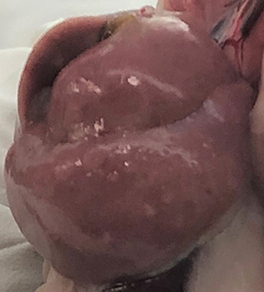
Figure 9: Liver of C57BL/6NTac mouse on
NASH diet D09100310i for 53 weeks
displays moderate diffuse hepatomegaly
with steatosis along with visible lesions
with fat-like deposit appearance
measuring approximately 0.1 - 0.4 cm
on serosal side.

Figure 10: Liver of C57BL/6NTac mouse
on NASH diet D09100310i for 53
weeks displays moderate diffuse
hepatomegaly with steatosis along
with a hepatic mass measuring
approximately 0.8 cm, located between
the left and caudal lobe.
General chow control mouse findings: All mice were bright, alert and responsive. Fur coat appeared well groomed with mild oily appearance. Intermittent lighter colored tips on hairshafts of fur coat. Body condition score was 3-4 for controls at 33 and 41 weeks of age and 4 for controls at 59 weeks of age. All animals had adequate to plentiful mesentary and subcutaneous adipose tissue present. Liver appeared grossly dark pink with uniform color and texture, except in 2 males at 59 weeks for which liver appeared mildly pale with a mild icteric tinge in 2 of 5 males. No masses or lesions were observed on serosal or cut side of livers.
The histopathology report for 59 week old control mice identified an incidental finding in 3 of 5 mice (M18, M19, M20): the presence of large aggregates of mononuclear cells including large and small lymphocytes, plasma cells and dendritic-like cells adjacent to central veins. These aggregates have features of lymphocyte neoplasia most consistent with follicular lymphoma (also described as follicular B-cell lymphoma), a common age-related neoplastic condition of C57BL/6 mice.
Liver as % of Bodyweight

Figure 11
Table 1: Download raw data: bodyweight and liver weight.
| Group | Mouse ID | Body Weight (g) | Liver Weight (g) | Liver as % of BW |
|---|---|---|---|---|
| NASH 22 wks old (16 wks on diet) | H831 | 37.5 | 2.5 | 6.7% |
| NASH 22 wks old (16 wks on diet) | H832 | 43.5 | 3.2 | 7.4% |
| NASH 22 wks old (16 wks on diet) | H833 | 42.5 | 2.9 | 6.8% |
| NASH 22 wks old (16 wks on diet) | H834 | 44.0 | 3.5 | 8.0% |
| NASH 22 wks old (16 wks on diet) | H835 | 39.9 | 3.3 | 8.3% |
| NASH 22 wks old (16 wks on diet) | H841 | 45.0 | 4.0 | 8.9% |
| NASH 22 wks old (16 wks on diet) | H842 | 48.9 | 5.5 | 11.2% |
| NASH 22 wks old (16 wks on diet) | H843 | 41.0 | 4.4 | 10.7% |
| NASH 22 wks old (16 wks on diet) | H844 | 46.2 | 4.8 | 10.4% |
| NASH 22 wks old (16 wks on diet) | H845 | 40.8 | 3.2 | 7.8% |
| NASH 33 wks old (27 wks on diet) | M671 | 46.8 | 3.69 | 7.9% |
| NASH 33 wks old (27 wks on diet) | M672 | 42.3 | 3.69 | 8.7% |
| NASH 33 wks old (27 wks on diet) | M673 | 44.4 | 3.96 | 8.9% |
| NASH 33 wks old (27 wks on diet) | M674 | 45.1 | 3.96 | 8.8% |
| NASH 33 wks old (27 wks on diet) | M675 | 44.1 | 4.13 | 9.4% |
| NASH 33 wks old (27 wks on diet) | M676 | 48.0 | 5.23 | 10.9% |
| NASH 33 wks old (27 wks on diet) | M677 | 41.1 | 3.14 | 7.6% |
| NASH 33 wks old (27 wks on diet) | M678 | 45.2 | 4.57 | 10.1% |
| NASH 33 wks old (27 wks on diet) | M679 | 43.9 | 3.66 | 8.3% |
| NASH 33 wks old (27 wks on diet) | M680 | 45.8 | 4.24 | 9.3% |
| Chow Control 33 wks old | M1 | 31.5 | 1.47 | 4.7% |
| Chow Control 33 wks old | M2 | 29.4 | 1.28 | 4.4% |
| Chow Control 33 wks old | M3 | 35.7 | 1.49 | 4.2% |
| Chow Control 33 wks old | M4 | 31.4 | 1.32 | 4.2% |
| Chow Control 33 wks old | M5 | 29.9 | 1.35 | 4.5% |
| Chow Control 33 wks old | M11 | 35.3 | 1.6 | 4.5% |
| Chow Control 33 wks old | M12 | 31.1 | 1.42 | 4.6% |
| Chow Control 33 wks old | M13 | 40.8 | 1.8 | 4.4% |
| Chow Control 33 wks old | M14 | 31.2 | 1.52 | 4.9% |
| Chow Control 33 wks old | M15 | 30.6 | 1.44 | 4.7% |
| NASH 41 wks old (35 wks on diet) | M686 | 50.3 | 4.78 | 9.5% |
| NASH 41 wks old (35 wks on diet) | M687 | 41.4 | 3.79 | 9.2% |
| NASH 41 wks old (35 wks on diet) | M688 | 49.2 | 4.51 | 9.2% |
| NASH 41 wks old (35 wks on diet) | M689 | 45.1 | 6.27 | 13.9% |
| NASH 41 wks old (35 wks on diet) | M690 | 44.8 | 6.43 | 14.4% |
| NASH 41 wks old (35 wks on diet) | M691 | 47.6 | 4.4 | 9.2% |
| NASH 41 wks old (35 wks on diet) | M692 | 57.2 | 5.52 | 9.7% |
| NASH 41 wks old (35 wks on diet) | M693 | 47.3 | 4.06 | 8.6% |
| NASH 41 wks old (35 wks on diet) | M694 | 47.2 | 4.22 | 8.9% |
| NASH 41 wks old (35 wks on diet) | M695 | 49.9 | 4.15 | 8.3% |
| Chow Control 41 wks old | M6 | 44.7 | 2.12 | 4.7% |
| Chow Control 41 wks old | M7 | 36.7 | 1.73 | 4.7% |
| Chow Control 41 wks old | M8 | 31.6 | 1.36 | 4.3% |
| Chow Control 41 wks old | M9 | 32.5 | 1.44 | 4.4% |
| Chow Control 41 wks old | M10 | 32.6 | 1.55 | 4.8% |
| NASH 59 wks of age (53 wks on diet) | M770 | 50.6 | 5.3 | 10.5% |
| NASH 59 wks of age (53 wks on diet) | M430 | 47.6 | 4.6 | 9.7% |
| NASH 59 wks of age (53 wks on diet) | M431 | 47.8 | 4.4 | 9.2% |
| NASH 59 wks of age (53 wks on diet) | M442 | 53.1 | 5.3 | 10.0% |
| NASH 59 wks of age (53 wks on diet) | M443 | 54.4 | 6.3 | 11.6% |
| NASH 59 wks of age (53 wks on diet) | M444 | 56.0 | 5.5 | 9.8% |
| NASH 59 wks of age (53 wks on diet) | M445 | 55.2 | 6.4 | 11.6% |
| NASH 59 wks of age (53 wks on diet) | M652 | 43.9 | 4.7 | 10.7% |
| NASH 59 wks of age (53 wks on diet) | M653 | 59.6 | 5.8 | 9.7% |
| NASH 59 wks of age (53 wks on diet) | M655 | 48.6 | 4.9 | 10.1% |
| Chow Control 59 wks of age | M16 | 48.8 | 2.67 | 5.5% |
| Chow Control 59 wks of age | M17 | 39.3 | 1.94 | 4.9% |
| Chow Control 59 wks of age | M18 | 42.0 | 2.18 | 5.2% |
| Chow Control 59 wks of age | M19 | 36.7 | 1.51 | 4.1% |
| Chow Control 59 wks of age | M20 | 36.5 | 1.36 | 3.7% |
H&E all timepoints
Nash B6
27 Weeks On Diet

35 Weeks On Diet
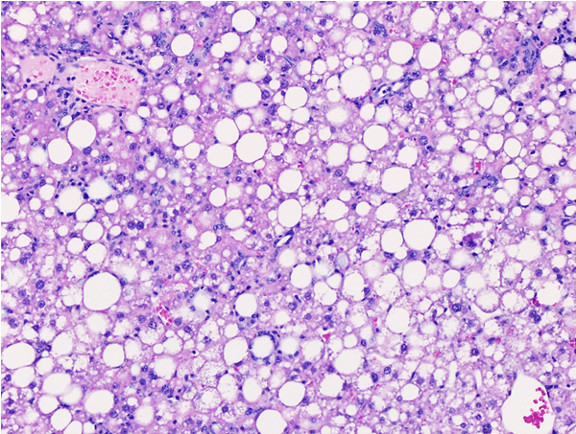
53 Weeks On Diet

Control B6


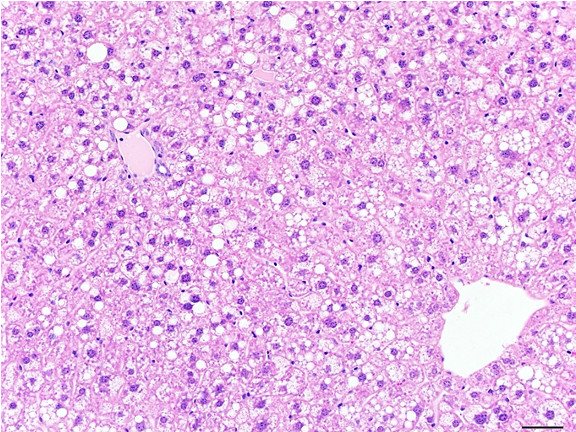
Adipophilin all timepoints
Nash B6
27 Weeks On Diet

35 Weeks On Diet
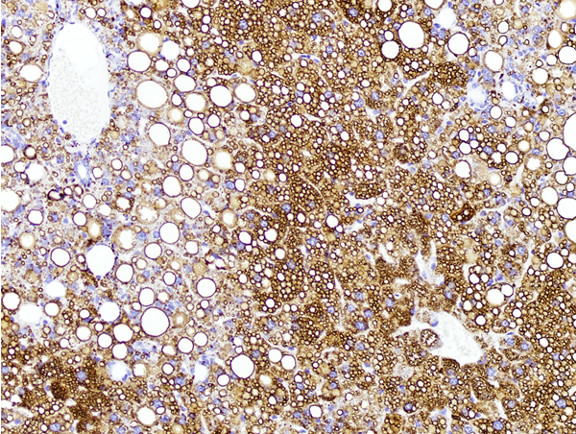
53 Weeks On Diet

Control B6



α-SMA all timepoints
Nash B6
27 Weeks On Diet

35 Weeks On Diet

53 Weeks On Diet

Control B6



Picrosirius red all timepoints
Nash B6
27 Weeks On Diet

35 Weeks On Diet

53 Weeks On Diet

Control B6
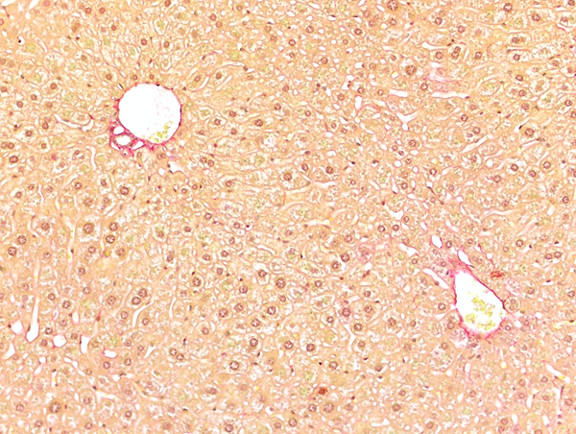

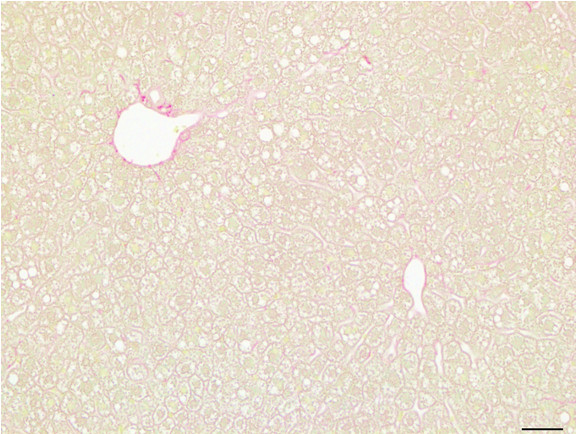
Hydroxyproline detection by IHC, 28 weeks on diet
Nash B6
10x

40x

Control B6
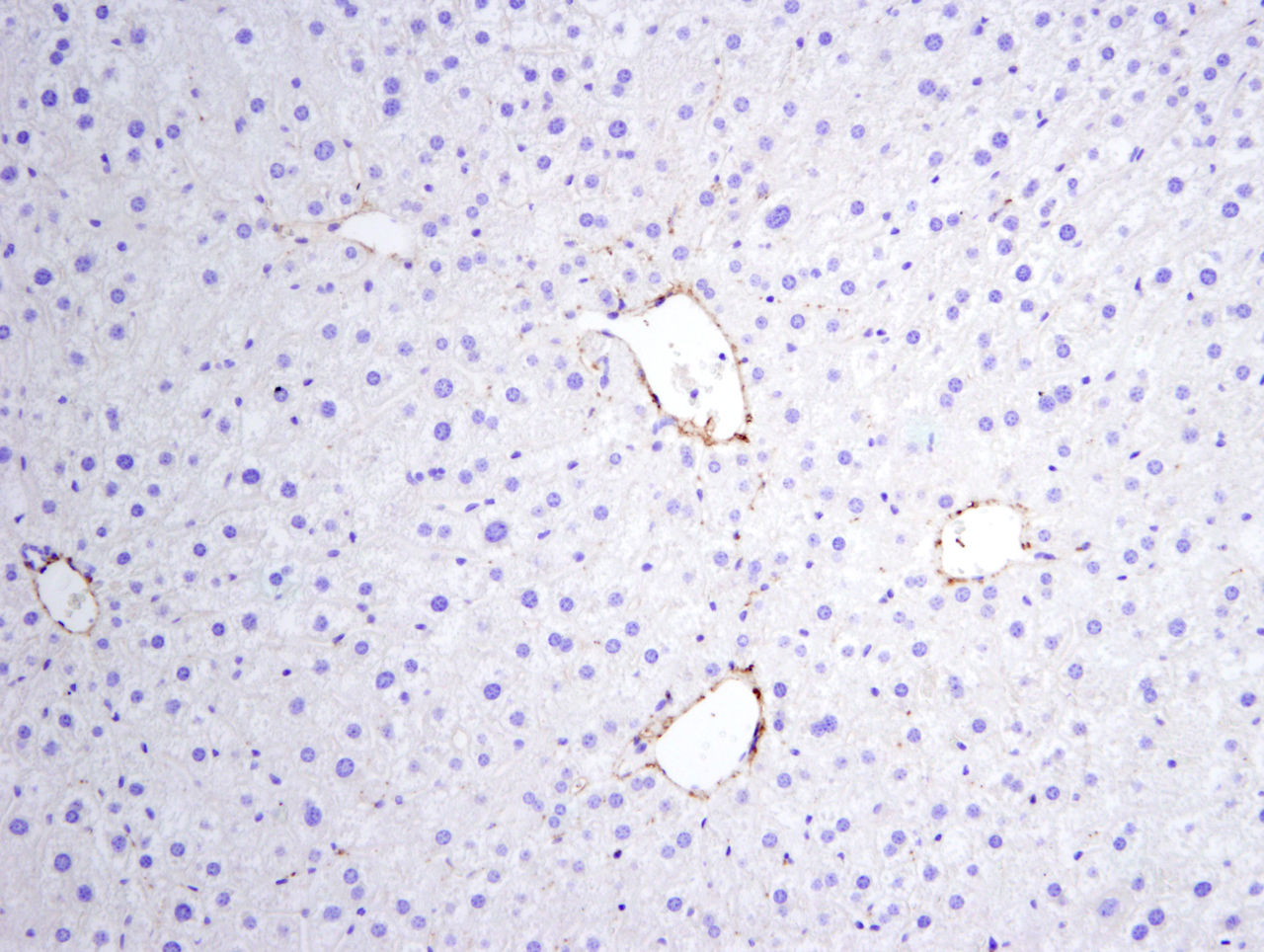
Immunohistochemical analysis of paraffin-embedded mouse liver using Hydroxyproline Antibody # 73812 from Cell Signaling Technology.
27 weeks on diet all stains/IHC
Nash B6
H&E

Adipophilin

α-SMA
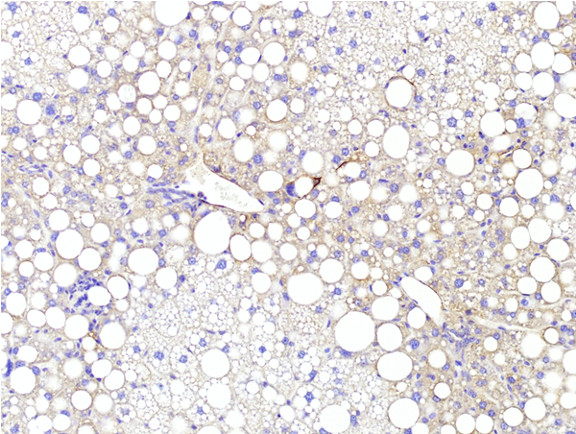
Picrosirius red

Control B6




Hydroxyproline detection by IHC, 28 weeks on diet
Nash B6
10x

40x

Control B6

Immunohistochemical analysis of paraffin-embedded mouse liver using Hydroxyproline Antibody # 73812 from Cell Signaling Technology.
35 weeks on diet all stains/IHC
Nash B6
H&E

Adipophilin

α-SMA

Picrosirius red

Control B6




53 weeks on diet all stains/IHC
Nash B6
H&E
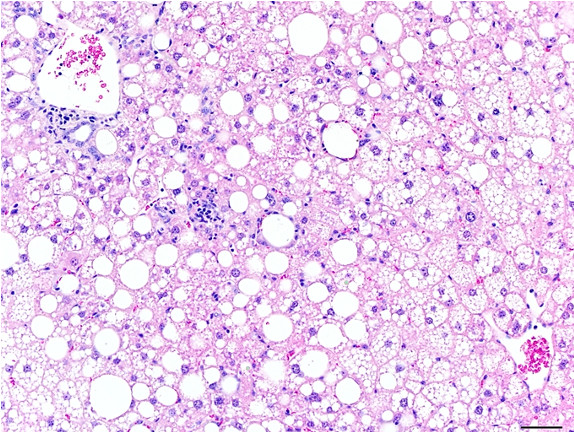
Adipophilin

α-SMA

Picrosirius red

Control B6




Other findings
Mallory-Denk bodies in NASH animal on diet 53 weeks, H&E 40x
Focus of hepatocellular alteration and proliferation in NASH animal on diet 53 weeks, H&E 10x
Bridging fibrosis in NASH animal on diet 53 weeks, Picrosirius red 10x Bridging fibrosis was observed in 1 out of 10 NASH mice at 53 weeks on diet.



Adenoma in NASH animal on diet for 53 weeks, H&E, 4x
Adenoma with hyaline inclusions (blue arrows) in NASH animal on diet for 53 weeks, H&E, 20x


Diet Induced NASH B6 mice are placed on a modified AMLN diet (D09100310i) starting at 6 weeks of age. Controls are fed NIH-31M. We are not able to accept NASH B6 orders by weight. Animals can lose weight in transit; for ground transit over 48 hours or air transit, mice may require extended acclimation time (2-4 weeks). We recommend acclimation time extends until mice have returned to within 5% of their pre-shipment bodyweight.
- Licensing
- Pricing - USD
- Pricing - EUR
- Pricing - USD Nonprofit
- Pricing - EUR Nonprofit
- Select my Health Standard
- Get Custom Pricing Guide
Licensing
Terms of Sale and Use for Diet Induced NASH B6
These models are sold subject to Taconic's Terms and Conditions for Taconic's Models, Products and Services
Pricing - USD
Murine Pathogen Free (MPF) Health Standard
NASH Male
NASH-B6-M
Available now
| Age in Weeks | Quantity 1 - 999 |
|---|---|
| 9 to 10 | $ 138.00 |
| 11 to 12 | $ 163.00 |
| 13 to 14 | $ 189.00 |
| 15 to 16 | $ 220.00 |
| 17 to 18 | $ 247.00 |
| 19 to 20 | $ 272.00 |
| 21 to 22 | $ 300.00 |
| 23 to 24 | $ 342.00 |
| 25 to 26 | $ 351.00 |
| 27 to 28 | $ 379.00 |
| 29 to 30 | $ 408.00 |
| 31 to 32 | $ 435.00 |
| 33 to 34 | $ 462.00 |
| 35 to 36 | $ 490.00 |
| 37 to 38 | $ 516.00 |
| 39 to 40 | $ 545.00 |
| 41 to 42 | $ 572.00 |
| 43 to 44 | $ 598.00 |
| 45 to 46 | $ 627.00 |
NASH-B6-CONTROL-M
Available now
| Age in Weeks | Quantity 1 - 999 |
|---|---|
| 9 to 10 | $ 56.00 |
| 11 to 12 | $ 72.00 |
| 13 to 14 | $ 88.00 |
| 15 to 16 | $ 102.00 |
| 17 to 18 | $ 115.00 |
| 19 to 20 | $ 130.00 |
| 21 to 22 | $ 142.00 |
| 23 to 24 | $ 156.00 |
| 25 to 26 | $ 169.00 |
| 27 to 31 | $ 196.00 |
| 32 to 36 | $ 224.00 |
| 37 to 40 | $ 251.00 |
| 41 to 44 | $ 278.00 |
| 45 to 46 | $ 306.00 |
Pricing - EUR
Murine Pathogen Free (MPF) Health Standard
NASH Male
NASH-B6-M
Available now
| Age in Weeks | Quantity 1 - 999 |
|---|---|
| 9 to 10 | 126,00 € |
| 11 to 12 | 148,00 € |
| 13 to 14 | 172,00 € |
| 15 to 16 | 200,00 € |
| 17 to 18 | 225,00 € |
| 19 to 20 | 248,00 € |
| 21 to 22 | 273,00 € |
| 23 to 24 | 311,00 € |
| 25 to 26 | 319,00 € |
| 27 to 28 | 345,00 € |
| 29 to 30 | 371,00 € |
| 31 to 32 | 396,00 € |
| 33 to 34 | 420,00 € |
| 35 to 36 | 446,00 € |
| 37 to 38 | 470,00 € |
| 39 to 40 | 496,00 € |
| 41 to 42 | 521,00 € |
| 43 to 44 | 544,00 € |
| 45 to 46 | 571,00 € |
NASH-B6-CONTROL-M
Available now
| Age in Weeks | Quantity 1 - 999 |
|---|---|
| 9 to 10 | 51,00 € |
| 11 to 12 | 66,00 € |
| 13 to 14 | 80,00 € |
| 15 to 16 | 93,00 € |
| 17 to 18 | 105,00 € |
| 19 to 20 | 118,00 € |
| 21 to 22 | 129,00 € |
| 23 to 24 | 142,00 € |
| 25 to 26 | 154,00 € |
| 27 to 31 | 178,00 € |
| 32 to 36 | 204,00 € |
| 37 to 40 | 228,00 € |
| 41 to 44 | 253,00 € |
| 45 to 46 | 278,00 € |
Pricing - USD Nonprofit
Murine Pathogen Free (MPF) Health Standard
NASH Male
NASH-B6-M
Available now
| Age in Weeks | Quantity 1 - 999 |
|---|---|
| 9 to 10 | $ 138.00 |
| 11 to 12 | $ 163.00 |
| 13 to 14 | $ 189.00 |
| 15 to 16 | $ 220.00 |
| 17 to 18 | $ 247.00 |
| 19 to 20 | $ 272.00 |
| 21 to 22 | $ 300.00 |
| 23 to 24 | $ 342.00 |
| 25 to 26 | $ 351.00 |
| 27 to 28 | $ 379.00 |
| 29 to 30 | $ 408.00 |
| 31 to 32 | $ 435.00 |
| 33 to 34 | $ 462.00 |
| 35 to 36 | $ 490.00 |
| 37 to 38 | $ 516.00 |
| 39 to 40 | $ 545.00 |
| 41 to 42 | $ 572.00 |
| 43 to 44 | $ 598.00 |
| 45 to 46 | $ 627.00 |
NASH-B6-CONTROL-M
Available now
| Age in Weeks | Quantity 1 - 999 |
|---|---|
| 9 to 10 | $ 56.00 |
| 11 to 12 | $ 72.00 |
| 13 to 14 | $ 88.00 |
| 15 to 16 | $ 102.00 |
| 17 to 18 | $ 115.00 |
| 19 to 20 | $ 130.00 |
| 21 to 22 | $ 142.00 |
| 23 to 24 | $ 156.00 |
| 25 to 26 | $ 169.00 |
| 27 to 31 | $ 196.00 |
| 32 to 36 | $ 224.00 |
| 37 to 40 | $ 251.00 |
| 41 to 44 | $ 278.00 |
| 45 to 46 | $ 306.00 |
Pricing - EUR Nonprofit
Murine Pathogen Free (MPF) Health Standard
NASH Male
NASH-B6-M
Available now
| Age in Weeks | Quantity 1 - 999 |
|---|---|
| 9 to 10 | 126,00 € |
| 11 to 12 | 148,00 € |
| 13 to 14 | 172,00 € |
| 15 to 16 | 200,00 € |
| 17 to 18 | 225,00 € |
| 19 to 20 | 248,00 € |
| 21 to 22 | 273,00 € |
| 23 to 24 | 311,00 € |
| 25 to 26 | 319,00 € |
| 27 to 28 | 345,00 € |
| 29 to 30 | 371,00 € |
| 31 to 32 | 396,00 € |
| 33 to 34 | 420,00 € |
| 35 to 36 | 446,00 € |
| 37 to 38 | 470,00 € |
| 39 to 40 | 496,00 € |
| 41 to 42 | 521,00 € |
| 43 to 44 | 544,00 € |
| 45 to 46 | 571,00 € |
NASH-B6-CONTROL-M
Available now
| Age in Weeks | Quantity 1 - 999 |
|---|---|
| 9 to 10 | 51,00 € |
| 11 to 12 | 66,00 € |
| 13 to 14 | 80,00 € |
| 15 to 16 | 93,00 € |
| 17 to 18 | 105,00 € |
| 19 to 20 | 118,00 € |
| 21 to 22 | 129,00 € |
| 23 to 24 | 142,00 € |
| 25 to 26 | 154,00 € |
| 27 to 31 | 178,00 € |
| 32 to 36 | 204,00 € |
| 37 to 40 | 228,00 € |
| 41 to 44 | 253,00 € |
| 45 to 46 | 278,00 € |
Select my Health Standard
Need help choosing the right Taconic Biosciences health standard for your research?
Use the Health Standard Selector to enter your exclusion list. The tool will tell you which health standards meet your requirements.
Get custom pricing guide
Schedule A Scientific Consultation
Speak with a PhD-level Field Application Scientist who can help you select the most appropriate model and maximize your experimental success.
Related Models
Smart Select Program
Trial an Animal Model for Quality & Compatibility Assurance
As longtime facilitators of animal-based research, we understand the importance of aligning your project goals and procurement priorities to support advancements in your research.
- Evaluate a specific model strain, before making any financial investment
- Request up to 20 animals from one of the strains listed below, to test for quality, consistency, and suitability for your experimental purpose
- Enjoy free ground shipping, where applicable (see table for more details)*















.jpg)

.jpg)
.jpg)
.jpg)
.jpg)





.jpg)


.jpg)
.jpg)

.jpg)


.jpg)





.jpg)

.jpg)



















